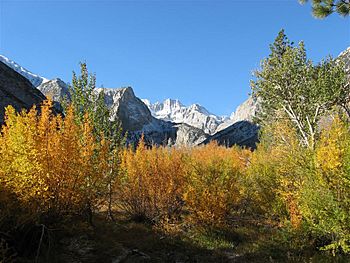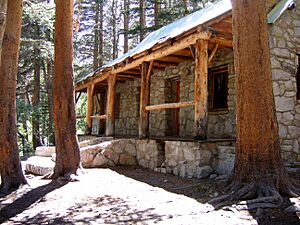Big Pine Creek (California) facts for kids
Quick facts for kids Big Pine Creek |
|
|---|---|

View of Norman Clyde Peak from Big Pine Creek, autumn
|
|
| Country | United States |
| State | California |
| Region | Inyo County |
| District | Inyo National Forest |
| Physical characteristics | |
| Main source | Sierra Nevada 37°07′29″N 118°26′13″W / 37.12472°N 118.43694°W |
| River mouth | Owens River 37°10′22″N 118°15′34″W / 37.17278°N 118.25944°W |
Big Pine Creek is a stream in eastern California, about 12.1 miles (19.5 km) long. It flows through Inyo County. This creek starts high up in the Sierra Nevada mountains. It then flows down into the Owens Valley. Big Pine Creek is an important branch, or "tributary," of the Owens River. It joins the Owens River near the town of Big Pine.
Contents
Where Does Big Pine Creek Start?
The very beginning of Big Pine Creek is in the eastern Sierra Nevada mountains. This starting point is called its "headwaters." The creek forms where two smaller streams meet. These are called the North Fork and South Fork of Big Pine Creek. They come together below a mountain area known as the Palisades.
The Creek's Journey
From its start, Big Pine Creek flows towards the east and northeast. It passes by Crater Mountain, which is part of a volcanic area. The creek then meets the Big Pine Canal. Finally, it flows into the Owens River near the town of Big Pine. Most of the water in this area comes from Big Pine Creek itself.
How Big Pine Creek Is Used
The Big Pine Canal helps move water around the area. Even though it has "Big Pine" in its name, this canal gets its water from the Owens River, not Big Pine Creek. The canal provides water for many uses in the Big Pine area. This includes watering crops (irrigation) and for fun activities. It also helps refill underground water supplies.
Power from the Creek
There are no large dams or lakes built on Big Pine Creek. However, the Los Angeles Department of Water and Power uses the creek's flow. They operate a power plant that makes electricity from the water. This is called a hydroelectric plant. Some of the creek's water is also used by people for their homes. It is also used to water crops on nearby Indian reservations.
A Special Historic Cabin
A famous actor named Lon Chaney once had a special stone cabin built here. It was located on the North Fork of Big Pine Creek. He used it as a quiet place to get away. The cabin was designed in 1929 by a well-known architect, Paul R. Williams. This cabin is still standing today. It is protected within the Inyo National Forest. It is also listed as a historic place.
Lakes Above the Cabin
High above Lon Chaney's cabin, there are many beautiful lakes. Some of these lakes have a greenish color. This color comes from tiny bits of rock and minerals. These bits are carried into the lakes by melting ice from glaciers.


